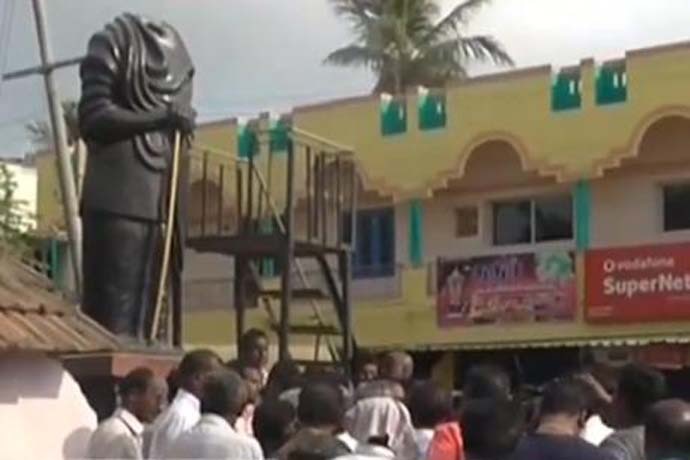When statues are vandalised: It is not opposition to a thought process. It is the savagery of action that is the worrying part

From Periyar to Ambedkar, Mahatma Gandhi to Rajiv Gandhi, vandalising statues has become the new normal. Does this represent an intellectual anger? Or something far more sinister?
As election fever only rises, in another incident of vandalism, last week, a statue of the Dravidian ideologue Periyar was found vandalised on Monday, in Aranthangi in Tamil Nadu’s Pudukkottai district.
According to reports, no arrests were immediately made, though the police detained a few people seen on CCTV footage in connection with the incident. Repair works were then carried out to restore the statue, and the incident was condemned by political leaders from across party lines. MDMK chief Vaiko said, “It is highly condemnable that a section of people who could not counter Periyar’s ideologies are now stooping to the lowest level by breaking his statues. Those intending to create law and order issues at the time of elections will never succeed.”
Tamil Nadu goes to the polls on April 18.

But the case of statue vandalism itself is not new in India. It happens ahead of every major political event and offers all political parties a good chance to blame one another.
Take the case of Varanasi. On March 14, some unidentified miscreants reportedly vandalised a statue of Dr Bhim Rao Ambedkar in the city’s Cholapur area. As is the norm, a case has been registered against “unidentified miscreants” and, as ever, “further investigations are on.”
Another statue of Ambedkar was vandalised in February 2019 in Meerut district (UP). A day after the vandalism of Ambedkar's statue in Meerut, another incident was reported from Jaunpur where a statue of Lord Buddha was vandalised by unknown miscreants.
In December last year, a statue of former Prime Minister Rajiv Gandhi was defaced, allegedly by Shiromani Akali Dal workers, near Ludhiana in Punjab. The face of the statue was painted black and the hands were painted red. The miscreants reportedly defaced the statue, accusing the former PM and the Congress of the killings of hundreds of Sikhs in the 1984 anti-Sikh riots. The Assembly elections in Punjab were held in 2017 and the Shiromani Akali Dal lost to the Congress by a margin of over two lakh votes. According to Punjab's Chief Minister Amarinder Singh, the incident was in desperation to grab votes ahead of the Lok Sabha polls.
It doesn't stop at who's fighting polls though.
A week ahead of Gandhi Jayanti, a statue of Mahatma Gandhi was found vandalised at Kacheripady in Kochi last year. There were reports of defacing and vandalising a statue of Jawaharlal Nehru in Rajasthan's Bundi in June 2018.
Rajasthan: Unidentified miscreants put a tyre around the statue of Jawaharlal Nehru at Bundi's Azad Park on June 21, police later removed the tyre off the statue. Police say 'Matter is being investigated. Action will be taken against miscreants.' pic.twitter.com/Snj52Gt3nJ
— ANI (@ANI) June 23, 2018
These are not isolated incidents. Many more incidents of such vandalism have come to light in the recent past, particularly in the run-up to the Lok Sabha elections. Statues of Lenin in Tripura, Periyar in Tamil Nadu, Syama Prasad Mookerjee in Kolkata and BR Ambedkar in Meerut were vandalised, all in a span of two days in March last year.
While the Prime Minister has condemned the incidents in the past, and there have been clear directives from the Ministry of Home Affairs, there has been no end to the incidents of vandalism of statues of iconic leaders and historic ideologues.
E V Ramaswamy — known to the Tamil populace as Thanthai (Father) Periyar (The Great Man) — has been, and is, a controversial figure for Tamils. He was the founder of the non-political social outfit, the Dravidar Kazhagam, whose political offshoots — DMK, AIADMK, MDMK — have defined Tamil politics.
While some hail him for his rousing messages of rationalism and self-respect for the so-called Shudras, others decry him as anti-Brahmin. Periyar was a staunch atheist who burnt pictures of Lord Rama and vandalised statues of Lord Ganesha, and was completely intolerant of religion and the superstitions synonymous with religion in that era.
However, his tolerance of the opposing school of thought ran deeper than his anti-societal ideologies. The radical revolutionary's confidant and voice of reason was C Rajagopalachari — a staunch Brahmin and a theist. Rajaji was the antithesis of everything that Periyar stood for — but he was also someone Periyar always referred to as Acharyar (preceptor).
Clearly, very little of the preachings of any tolerant and open-minded ideologue has penetrated into our society today. The "them-versus-us" narrative seems to be dictating our thoughts, actions and lives.
While vandalising statues of historical figures and political ideologues has become the new normal expression of dissent between political parties, the savage thought process in mutilating these figurines is more worrying. While dissent and ideological differences towards the political leaders of yesteryears form the basis of any healthy society, it is the violent expression of this intolerance that is disturbing.
Vandalism and defacing statues is an expression akin to physically harming opposing voices.
Had the leaders been alive, these people vandalising their statues now would have perhaps wanted to behead the leaders or mutilate them, just as they do to the statue.
If the rage of intolerance runs this deep in a society, it is time we shook ourselves awake and asked whether we even deserve our famous diversity in thoughts, ideologies and leadership? Are we mature enough to handle a democratic society?
Or should we all, in fact, turn into living statues, with nary a free thought in stone heads and hearts?

